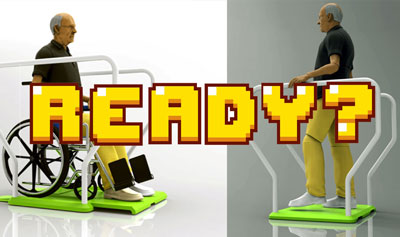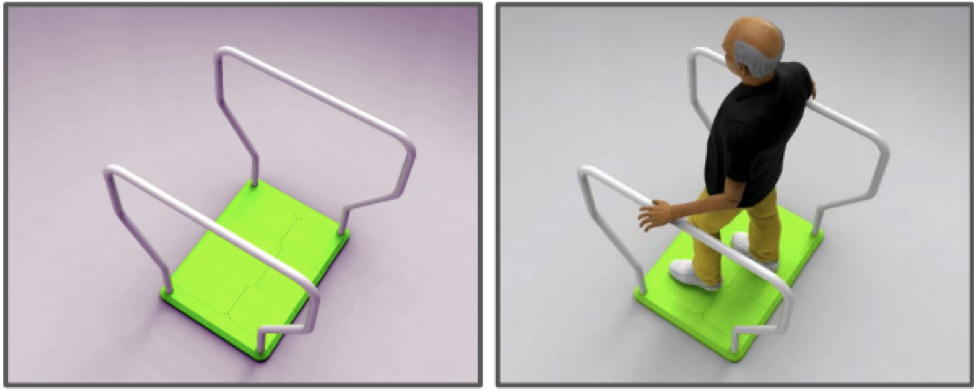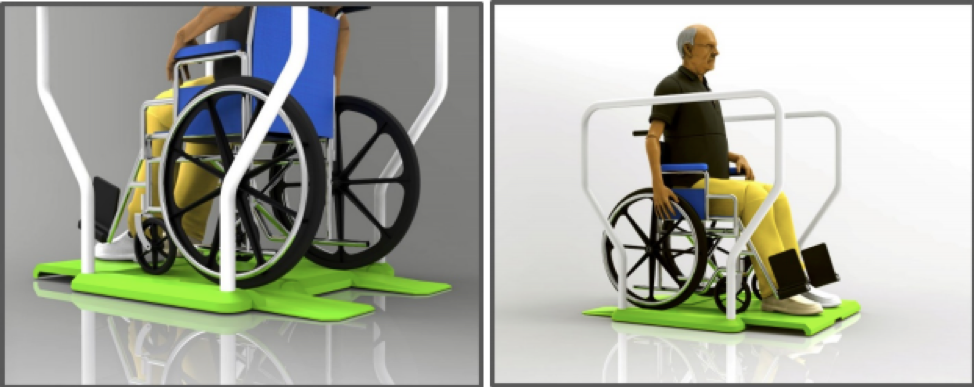Media contact: Yvonne Taunton
 Life in a nursing facility doesn’t tend to move fast, and it certainly isn’t exciting.
Life in a nursing facility doesn’t tend to move fast, and it certainly isn’t exciting.
That’s unfortunate; studies show that, without activities to engage their bodies and minds, residents tend to decline more quickly. But a clever new device designed by UAB undergraduates aims to get residents moving, and interacting, through the power of videogames.
The Wii Balance Board introduced millions of Americans, many of them with no prior interest in gaming, to the concept of moving their bodies to control a digital avatar. Using the Balance Board requires balance, however. In a nursing facility, where the vast majority of residents need assistance to get around, that is a deal-breaker.
Active videogaming can “combat the severe lack of activities that promote physical engagement in the nursing care market,” says Emma Latham, a senior majoring in biomedical engineering in the UAB School of Engineering. But to bring “exer-gaming” to this market, aging tech like the Wii Balance Board needs an update. That’s where Latham and her partners, fellow biomedical engineering seniors Han Yu and Ruta Bhat, saw an opportunity for their capstone design project — and a potential business startup. The team will present their project at the 2018 UAB Spring Expo this week.
 The G-PAC — Gaming Platform for Activity and Coordination — offers hand rails to allow users to maintain balance and stability while playing. Images from Sean Simmons, Industrial Designer at Objective Design.
The G-PAC — Gaming Platform for Activity and Coordination — offers hand rails to allow users to maintain balance and stability while playing. Images from Sean Simmons, Industrial Designer at Objective Design.
'Accessible, non-stigmatizing'
There are currently more than 7 million Americans living in nursing facilities, and with the population over age 65 expected to double in the next four decades, those numbers are soaring. “The increasing number of tech-savvy people in nursing homes will push game makers to create A-list active videogames and virtual reality games tailored for the elderly,” Latham says. “We want to add value to this market on the hardware side by creating accessible, non-stigmatizing controllers to actuate those games.”
The team developed a concept: a platform surrounded by sensors that could translate a player’s movement into onscreen action, whether they were seated in a wheelchair or standing with the aid of supporting rails. They took their idea to professor Alan Eberhardt, Ph.D., who leads a National Science Foundation-project that charges fourth-year engineering students with designing devices to help children and adults with movement issues.
Eberhardt saw that the idea had true market potential. And Latham, who had already been hired for a full-time position on UAB’s Engineering and Innovative Technology Development (EITD) team, had the time to pursue the project past graduation. Latham and EITD electrical engineer Samuel Misko as well as a local industrial designer, Sean Simmons, enrolled in iCorps, a month-long startup bootcamp administered by UAB at Birmingham’s Innovation Depot.
 With the rails lowered and recessed tracks revealed, the G-PAC lets users in wheelchairs join in the action. Images from Sean Simmons, Industrial Designer at Objective Design.
With the rails lowered and recessed tracks revealed, the G-PAC lets users in wheelchairs join in the action. Images from Sean Simmons, Industrial Designer at Objective Design.
But will it sell?
“It’s a great program,” Latham says. “It focuses on customer discovery and your value proposition.” That includes a tough question that many startups fail to answer until it’s too late. “They pushed us to go out to see if people really need this,” Latham says. She and Misko met with activity coordinators and recreational therapists in 13 nursing care facilities in the Birmingham area. As the team noted in its final project paper, “The one constant among all the feedback was the need for active, physical engagement to keep residents entertained and spry.”
With funding from the National Institute on Disability and Rehabilitation Research, the team is now building a working prototype to demonstrate to investors, using tools like the computer-controlled X-carve machine in EITD to shape the wooden platform and hand rails, and using 3D printers within the facility to print various parts of the platform.
“We believe we are early in the game,” Latham says. “As people age and tech booms, there will be an even greater need for something like this in the future.”
Research 2.0
The G-PAC project is one of more than 250 projects that will be presented by more than 600 students at the 2018 UAB Spring Expo.
The event, which celebrates its 11th anniversary this year, showcases research, scholarship and other academic endeavors by UAB undergraduates on April 12 and 13.
